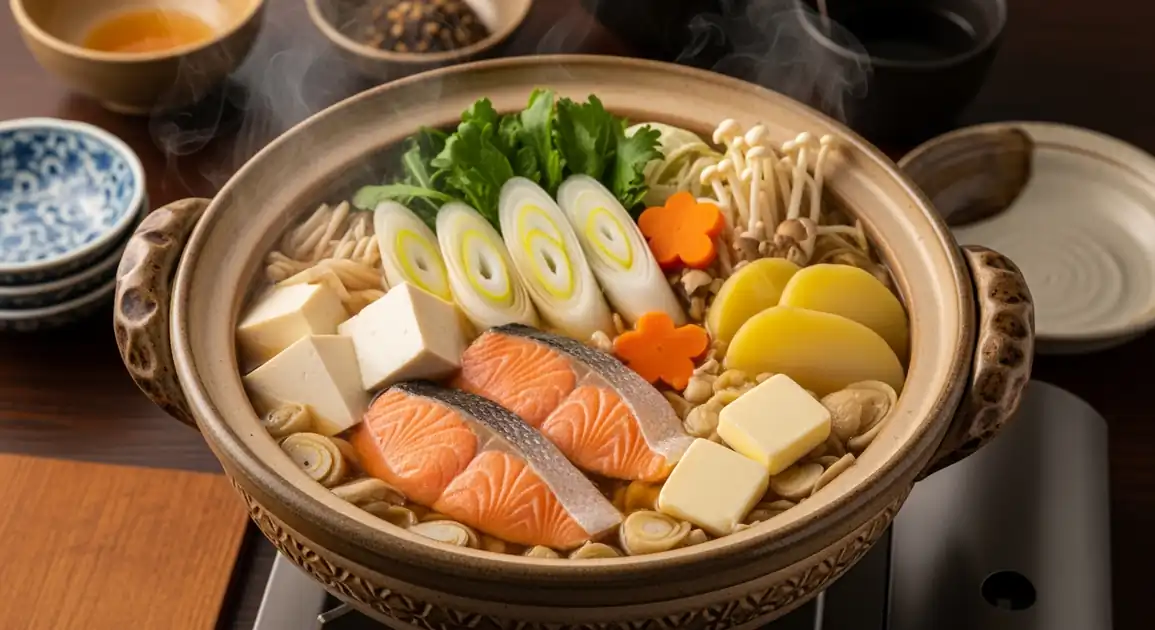Ishikari Nabe (Salmon Hot Pot)
石狩鍋

Description
Sapporo, Hokkaido's capital, offers Japan's most authentic and diverse Ishikari Nabe experiences. Located near the Ishikari River that gives the dish its name, Sapporo's restaurants pride themselves on freshness and adherence to traditional recipes while also embracing creative variations that showcase Hokkaido's premium ingredients.
Dietary Information
Serving information
Serving style
Traditionally served in a rustic earthenware pot placed on a flame at the table. Premium restaurants often provide individual servings in smaller pots. Almost always accompanied by rice served separately.
Quick facts
Most restaurants serve lunch 11 AM - 2 PM and dinner 5 PM - 10 PM. Some izakayas serve until midnight or later.
Safety Tips
What to Look For
-
Fresh, bright pink salmon with firm texture
The salmon should have vibrant color without brown spots or dull appearance. It should maintain its shape rather than breaking apart too easily, indicating it hasn't been frozen/thawed multiple times.
-
Clean, mild fishy aroma from the broth
A pleasant, subtle fish aroma indicates fresh ingredients. Strong fishy smells suggest lower quality or older fish.
-
Restaurants specializing in Hokkaido cuisine
Establishments that focus on Hokkaido regional food are more likely to use authentic recipes and source quality salmon.
-
Proper cooking temperature (gentle simmer)
The broth should be maintained at a gentle bubbling simmer, not a rolling boil which would overcook the salmon or a too-low temperature which might not cook ingredients thoroughly.
-
Seasonal availability emphasis
Good restaurants may only serve Ishikari Nabe during colder months when ingredients are at their peak quality and the dish is most appropriate.
What to avoid
-
Pre-cooked salmon added to the broth
Authentic preparation cooks the raw salmon directly in the hot pot. Pre-cooked salmon loses flavor and can indicate poor quality control.
-
Very fishy or ammonia-like smell
These odors indicate old or deteriorating fish, which could pose health risks.
-
Artificially bright red/orange salmon
Unnaturally vivid coloring may indicate artificial dyes used to mask lower quality fish.
-
Recycled broth
Some budget places might reuse broth from previous servings. Fresh broth should be prepared for each order.
-
Inconsistent ingredients across multiple visits
Quality restaurants maintain consistent standards for their signature dishes. Major variations in recipe or portion sizes may indicate corner-cutting.
Price information
Price range
Budget tips
- Local neighborhood restaurants away from tourist areas offer better value (1800-3000 JPY).
- Lunch sets are significantly cheaper than dinner, often by 30-40%.
- Many places offer 'teishoku' set meals with Ishikari Nabe as the main dish plus sides at better value.
- For budget options, look for restaurants around Susukino that cater to local workers.
- Some izakayas offer mini versions for solo diners at lower prices (1800-2500 JPY).
Value indicators
- Use of local Hokkaido salmon rather than imported.
- Generous salmon-to-vegetable ratio.
- House-made miso paste rather than commercial.
- Hokkaido-produced butter (often specifically mentioned on menu).
- Option to add high-quality Hokkaido rice at the end to soak up remaining broth.
Where to Find This Dish
Susukino
Sapporo's entertainment district features numerous izakayas and traditional restaurants serving Ishikari Nabe.
Ramen Yokocho, Tanuki Koji Shopping Arcade
Dinner (5 PM - 10 PM)
Central Sapporo/Odori
Restaurants around Odori Park often specialize in Hokkaido cuisine for both tourists and locals.
Odori Park, Sapporo TV Tower
Lunch (11 AM - 2 PM), Dinner (5 PM - 9 PM)
Curb Market (Nijo Market)
Seafood restaurants near this market often serve excellent Ishikari Nabe with the freshest ingredients.
Nijo Market
Lunch (11 AM - 2 PM)
Vendor Tips
- Restaurants displaying 'Hokkaido salmon' or 'Local salmon' signage typically offer superior quality.
- Ask where their salmon is sourced - authentic places will happily share this information.
- Some traditional restaurants require a minimum of two people for ordering nabe dishes.
- Reservations recommended for famous Ishikari Nabe specialists, especially in winter.
How to Order
Regional Variations
-
Sapporo-Style Traditional
(札幌風伝統石狩鍋)
The classic city preparation featuring generous salmon portions, miso broth, and a distinctive pat of Hokkaido butter.
-
Ishikari Nabe with Hokkaido Dairy
(北海道乳製品入り石狩鍋)
Enhanced with local cream or milk and extra butter, creating a richer broth that showcases Hokkaido's famous dairy products.
-
Luxury Ishikari Nabe
(豪華石狩鍋)
High-end version adding local Hokkaido scallops, crab, or uni (sea urchin) alongside the traditional salmon.
-
Genghis Khan Ishikari Nabe
(ジンギスカン石狩鍋)
Fusion variation incorporating Sapporo's other famous dish, Genghis Khan (grilled lamb), adding lamb slices to the traditional salmon hot pot.
-
Soup Curry Ishikari Nabe
(スープカレー石狩鍋)
Modern fusion incorporating elements of Sapporo's popular soup curry, with curry spices added to the miso broth base.
Cultural context
History
Ishikari Nabe originated among fishermen along Hokkaido's Ishikari River, one of Japan's premier salmon habitats. Dating back to the late 19th century, it began as a simple fisherman's meal using fresh-caught salmon cooked outdoors in portable pots. The dish evolved as Hokkaido's dairy industry developed, incorporating butter—a distinctive regional ingredient rare in traditional Japanese cuisine. Now considered Hokkaido's representative hot pot dish, it embodies the region's natural abundance and cultural history.
Local significance
In Sapporo, Ishikari Nabe represents local pride in Hokkaido's salmon fishing heritage. It's considered one of the representative dishes that showcases the region's superior ingredients and distinct culinary tradition.
Eating customs
- In Sapporo, it's common to add a bit of Hokkaido butter to your individual portion.
- Many locals finish the meal by adding a bowl of rice directly to the remaining broth.
- When dining with others, it's polite to serve them before serving yourself from the communal pot.